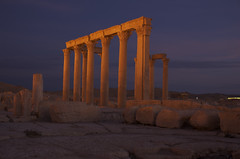Four weeks ago, a big survey of Richard Long's works opened at Tate Britain. Today I found the time to get down there and saw the most awesome exhibition in a long time. I'm not sure I'll be able to verbalize my impressions or rationalize my delight, but I can say one thing clearly and unambiguously. If you are anywhere near London before September, go see this show.
Richard Long is a most curious artist whose talent it is, by his own admission, "to walk across a moor". The fellow is an avid walker, doing small things like crossing the heaths near his native Bristol or big things like crossing Britain south to north in a dozen days, always on foot and always by himself. On the way, he manipulates nature in simple ways and documents that with his camera. He might put down a rock circle or produce scuff marks in a meadow. Some of these pictures hang in the exhibition but they are only a small part of it.
The bigger part is devoted to creative documentation. Some frames show the walks Long took as they appeared on the map but completely removed from their context. All you see is pencil lines on drawing paper. In other pieces are little arrows that indicate the wind speed at a given point during a walk, drawn at the geographic location where that wind direction was observed but, again, without the underlying map. A third type of artwork is a kind of minimalistic traveling poetry. Between the title and the details of the walk (approximate date and the time it took to cover the distance) are lines of words. These can be things he saw every ten miles or one sound for each day of a longer walk or forces that keep him going.
A beautiful example of this unexpected poetry is his Engadine walk that includes "one full moon" and "two thunderstorms", recounts observations in leaps and bounds, over "seventeen mountain passes" and "one hundred and eight stones added to a summit cairn", all the way to "countless stars" and "the infinity of space". The is no photo and no map, only letters on the wall and the magic that flows from them. The large capitals, sans-serif, black on white, couldn't be more minimal, and yet they are infinitely evocative.
I found the exhibition so powerful because it mostly happens in the mind of the visitor. The walls of the gallery are mostly bare but the space is filled with infinite possibilities, amplified by the thoughts of the beholder. I was filled with memories of walks I've taken and dreams of those I haven't. This was nothing concrete, I didn't have a sense of place or time, but I could imagine being in any of the photos. I could have climbed the mountain passes or seen the beauty in rock formations because this simple yet profound beauty is everywhere. For me, the experience was almost spiritual.
As much of the power of the exhibition derives from its simplicity, it is a classic case of “I could do this”, but you probably can't. First off, there is masterful artistry in all of the objects exhibited. The simple black-and-white photograph of a patch of flattened grass in an expanse of a fine dusting of snow, for example, is beautifully composed with the artist's backpack carefully thrown next to where his tent was pitched the night before. There is nothing random there. Then there is an abundance of creativity that permeates all works. Despite being highly similar in their conception – a walk from A to B for the most part – they're all different. They all have a different focus, an new idea behind them, something innovative.
As I ambled from room to room, awe-struck, reading the details under each documented walk, the number of days spent walking and the number of miles covered, the devil of reality started nagging me. I couldn't help wondering what kept the artist occupied. What kept him from getting bored? He's not in it for the sights, not to meet people, not to watch wildlife, or to take pictures. Some of his walks were so epic, in excess of forty miles a day for weeks, that he must have been near exhaustion. What kept him going? And what was going on in his head? Did he wish for the walk to be over? Did he long for his sofa? Was he imagining things? Talking to himself? Running his iPod dry?
There are some answers towards the exit, but they are more mystifying than illuminating. Richard Long finds two pleasures in walking, "the intellectual pleasure of original ideas and the physical pleasure of realizing them". That doesn't give anything away. Neither does a list of nouns he associates with his walks – independence, eating, a campsite at night. In the end, there is probably no point. The walk is the goal and the result stunning.

3 comments:
cool post
Well thank you. You keep me going ;-)
hmm, i dunno, he seems like a pretty cool dude to me, very simple...he definitely has life scaled down to minimal?...he obviously loves nature and i would think this keeps him at his work?
Post a Comment